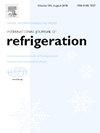无霜冰箱用小热容非均匀配电除霜加热器试验研究
IF 3.5
2区 工程技术
Q1 ENGINEERING, MECHANICAL
International Journal of Refrigeration-revue Internationale Du Froid
Pub Date : 2025-07-03
DOI:10.1016/j.ijrefrig.2025.07.002
引用次数: 0
摘要
冰箱是使用最广泛的制冷设备之一,在反复的冷却循环中,由于蒸发器结霜而面临效率下降的问题。目前采用钢管除霜加热器(STDH)来解决这一问题。然而,STDH的高热容量导致传热缓慢,导致除霜能耗显著,占系统总能耗的近12.0%。为了解决这一问题,本文提出了一种小热容量非均匀配电除霜加热器(LHNPDH)。LHNPDH的特点是电热丝缠绕在加热器的外表面,能够快速传递除霜热量。此外,加热器的功率分布可以通过改变加热丝的缠绕密度来调节,从而实现按需除霜。实验结果表明,与STDH相比,LHNPDH可将总除霜周期时间缩短25.1%,将冷冻室(FC)温升降低2.7℃,将最高FC温度降低4.1℃,将除霜能耗降低28.6%。因此,本研究开发的LHNPDH能够更加合理、高效地利用和分配除霜热量,最终实现制冷机有效节能2.6%。本文章由计算机程序翻译,如有差异,请以英文原文为准。
Experimental study on a low-heat-capacity non-uniform power distribution defrost heater for frost-free refrigerators
Refrigerators, among the most widely used refrigeration devices, face efficiency declines due to frost buildup on evaporators during repeated cooling cycles. Currently, steel tube defrost heaters (STDH) are employed to tackle this issue. However, the high heat capacity of the STDH results in slow heat transfer, leading to significant energy consumption for defrosting, which accounts for nearly 12.0 % of the total system energy consumption. To address this issue, this paper proposes a low-heat-capacity non-uniform power distribution defrost heater (LHNPDH). The LHNPDH features electric heating wires wound around the outer surface of the heater, enabling rapid transfer of defrosting heat. In addition, the power distribution of the heater can be adjusted across different regions by varying the winding density of the heating wire, thereby achieving on-demand defrosting. The experimental results demonstrate that, compared to STDH, LHNPDH can reduce the total defrosting cycle time by 25.1 %, decrease the temperature rise in the freezer compartment (FC) by 2.7 °C, lower the maximum FC temperature by 4.1 °C, and reduce defrosting energy consumption by 28.6 %. Therefore, the LHNPDH developed in this study can utilize and distribute defrost heat more rationally and efficiently, ultimately achieving an effective energy saving of 2.6 % for the refrigerator.
求助全文
通过发布文献求助,成功后即可免费获取论文全文。
去求助
来源期刊
CiteScore
7.30
自引率
12.80%
发文量
363
审稿时长
3.7 months
期刊介绍:
The International Journal of Refrigeration is published for the International Institute of Refrigeration (IIR) by Elsevier. It is essential reading for all those wishing to keep abreast of research and industrial news in refrigeration, air conditioning and associated fields. This is particularly important in these times of rapid introduction of alternative refrigerants and the emergence of new technology. The journal has published special issues on alternative refrigerants and novel topics in the field of boiling, condensation, heat pumps, food refrigeration, carbon dioxide, ammonia, hydrocarbons, magnetic refrigeration at room temperature, sorptive cooling, phase change materials and slurries, ejector technology, compressors, and solar cooling.
As well as original research papers the International Journal of Refrigeration also includes review articles, papers presented at IIR conferences, short reports and letters describing preliminary results and experimental details, and letters to the Editor on recent areas of discussion and controversy. Other features include forthcoming events, conference reports and book reviews.
Papers are published in either English or French with the IIR news section in both languages.

 求助内容:
求助内容: 应助结果提醒方式:
应助结果提醒方式:


